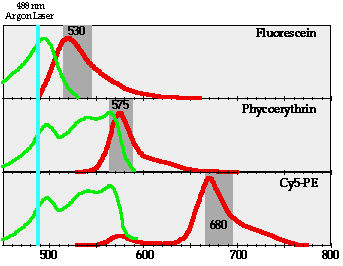
Why do we need Compensation?
(Go back to the introduction).
Compensation is the process by which we correct for "spillover".
Every fluorescent molecule emits light with a particular spectrum
unique to that molecule. These emission spectra overlap, in some
cases very significantly. For instance, see the spectra shown
below, for fluorescein ("FITC"), phycoerythrin (PE),
and Cy5-PE (also known as CyChrome).

In this figure, excitation spectra are shown in green, and
emission spectra in red. The light blue line is the wavelength
of an argon ion laser (488 nm). Notice that each of the three
dyes has a significant excitation at this wavelength. However,
when the dyes are excited, each emits with a characteristic spectrum:
fluorescein with a maximum around 520 nm, PE at about 575, and
Cy5PE at about 670.
In order to simultaneously measure these emissions, we choose
optical filters ("bandpass filters") which only transmit
specific wavelengths of light. The filters commonly used in flow
cytometry for these dyes are represented by the grey shaded areas.
In general, filters are chosen which collect the emitted light
near the emission maximum. For fluorescein, we use a "530/30"
filter, meaning that the filter has a pass-band centered on 530
nm, and the width of the pass-band is 30 nm.
However, it is impossible to choose filters which measure only
one dye. For instance, fluorescein has a significant emission
in the region that we measure PE (575 nm). Therefore, whenever
fluorescein is present, we will get signal in the 530 nm band,
and also in the 575 nm band. If PE is also present, it will contribute
to the 575 nm band. How then do we tell how much of the 575 fluorescence
is from PE, and how much is from FITC?
This is the process we term "compensation": i.e., correcting
for the amount for fluorescein fluorescence in the 575 nm band
so that we can figure out how much PE there is.
How compensation works...